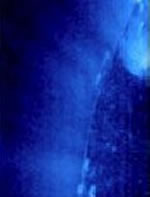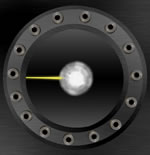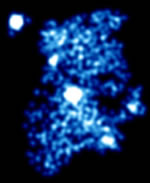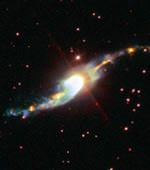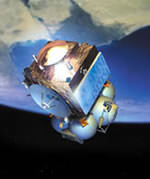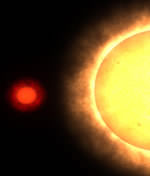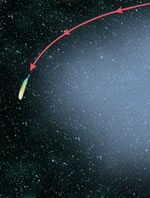
Image credit: NRAO
Before this week, “Complex H” was thought to be a strange cloud of stars with an unusual trajectory near the Milky Way. But as it turns out, this object is actually a companion galaxy crashing into the outer reaches of our own galaxy in exactly the opposite direction of the Milky Way’s rotation. New observations from the National Science Foundation’s Robert C. Byrd Green Bank Telescope (the world’s largest steerable radio telescope) have placed the object at 108,000 light years from the Milky Way’s centre.
New observations with National Science Foundation’s Robert C. Byrd Green Bank Telescope (GBT) suggest that what was once believed to be an intergalactic cloud of unknown distance and significance, is actually a previously unrecognized satellite galaxy of the Milky Way orbiting backward around the Galactic center.
Jay Lockman of the National Radio Astronomy Observatory (NRAO) in Green Bank, West Virginia, discovered that this object, known as “Complex H,” is crashing through the outermost parts of the Milky Way from an inclined, retrograde orbit. Lockman’s findings will be published in the July 1 issue of the Astrophysical Journal, Letters.
“Many astronomers assumed that Complex H was probably a distant neighbor of the Milky Way with some unusual velocity that defied explanation,” said Lockman. “Since its motion appeared completely unrelated to Galactic rotation, astronomers simply lumped it in with other high velocity clouds that had strange and unpredictable trajectories.”
High velocity clouds are essentially what their name implies, fast-moving clouds of predominately neutral atomic hydrogen. They are often found at great distances from the disk of the Milky Way, and may be left over material from the formation of our Galaxy and other galaxies in our Local Group. Over time, these objects can become incorporated into larger galaxies, just as small asteroids left over from the formation of the solar system sometimes collide with the Earth.
Earlier studies of Complex H were hindered because the cloud currently is passing almost exactly behind the outer disk of the Galaxy. The intervening dust and gas that reside within the sweeping spiral arms of the Milky Way block any visible light from this object from reaching the Earth. Radio waves, however, which have a much longer wavelength than visible light, are able to pass through the intervening dust and gas.
The extreme sensitivity of the recently commissioned GBT allowed Lockman to clearly map the structure of Complex H, revealing a dense core moving on an orbit at a 45-degree angle to the plane of the Milky Way. Additionally, the scientist detected a more diffuse region surrounding the central core. This comparatively rarefied region looks like a tail that is trailing behind the central mass, and is being decelerated by its interaction with the Milky Way.
“The GBT was able to show that this object had a diffuse ‘tail’ trailing behind, with properties quite different from its main body,” said Lockman. “The new data are consistent with a model in which this object is a satellite of the Milky Way in an inclined, retrograde orbit, whose outermost layers are currently being stripped away in its encounter with the Galaxy.”
These results place Complex H in a small club of Galactic satellites whose orbits do not follow the rotation of the rest of the Milky Way. Among the most prominent of these objects are the Magellanic Clouds, which also are being affected by their interaction with the Milky Way, and are shedding their gas in a long stream.
Since large galaxies, like the Milky Way, form by devouring smaller galaxies, clusters of stars, and massive clouds of hydrogen, it is not unusual for objects to be pulled into orbit around the Galaxy from directions other than that of Galactic rotation.
“Astronomers have seen evidence that this accreting material can come in from wild orbits,” said Butler Burton, an astronomer with the NRAO in Charlottesville, Virginia. “The Magellanic clouds are being torn apart from their interaction with the Milky Way, and there are globular clusters rotating the wrong way. There is evidence that stuff was going every-which-way at the beginning of the Galaxy, and Complex H is probably left over from that chaotic period.”
The new observations place Complex H at approximately 108,000 light-years from the Galactic center, and indicate that it is nearly 33,000 light-years across, containing approximately 6 million solar masses of hydrogen.
Radio telescopes, like the GBT, are able to observe these cold, dark clouds of hydrogen because of the natural electromagnetic radiation emitted by neutral atomic hydrogen at radio wavelengths (21 centimeters).
Globular clusters, and certain other objects in the extended Galactic halo, can be studied with optical telescopes because the material in them has collapsed to form hot, bright stars.
The GBT is the world’s largest fully steerable radio telescope. It was commissioned in August of 2000, and continues to be outfitted with the sensitive receivers and components that will allow it to make observations at much higher frequencies.
The National Radio Astronomy Observatory is a facility of the National Science Foundation, operated under cooperative agreement by Associated Universities, Inc.
Original Source: NRAO News Release

